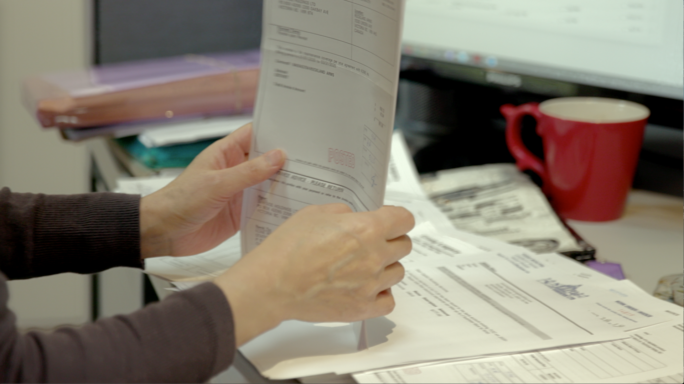Money Matters
How to write an invoice: What needs to be included
The complete guide to creating invoices for your business. Discover what you need to include on your invoices and how to get paid on time.


Cash is the lifeblood of any business and being paid on time is essential to keeping it flowing.
This starts with your invoices – documents that list the goods/services you’ve provided and how much is owed – aka the ‘bills’.
To get paid quicker, you could always use an automated solution that takes payments directly from your invoices.
But even without this, you’ll need a well-designed invoice to make a good impression on customers.
Whether you’re a sole trader, limited company or VAT-registered business, you’ll need to make sure your invoices include what’s legally required.
Using one of our invoice templates or accounting software makes it easy to create and send professional invoices that meet these requirements, look great, and help you get paid on faster.
But if you want to go solo, here’s a full guide on how to write an invoice yourself.
Here’s what we cover in this article:
- What should be included in an invoice?
- Different kinds of invoices
- Common invoice payment terms
- Common invoice payment methods
- Sending your invoice
- How to send your invoice
- How to get paid on time
What should be included in an invoice?
A standard (non-VAT) invoice must include:

1. ‘Invoice’
Identify the document with the word ‘invoice’ to differentiate from a quote, credit note or receipt.
2. A unique invoice number
The number must be unique to each invoice (without duplicates) for clear identification and you must keep a record of the numbers and references used.
Using a sequential numbering system is the easiest way to manage this.
The reference can contain letters as well as numbers.
3. Your company name and address
This is different for sole traders and limited companies but essentially, you must show clearly your trading name, business address and also, where you can be contacted by the customer, in case of query or dispute.
4. The company name and address of the customer
This is standard procedure on all invoices (except simplified VAT invoices) but is important for customers who want to claim back any VAT that has been charged.
5. A description of the goods/services
A clear description of the goods and services being invoiced for, with each service or item on a separate line for clear identification.
6. The date of supply
Known as the ‘supply date’, this is when the goods or services were issued. The supply date may be different to the invoice date but is usually within 30 days.
7. The date of the invoice
Date of when the invoice was generated and not when the goods were supplied.
8. The amount of the individual goods or services to be paid
If you have a list of items in the description, then each one will be marked with an individual amount.
9. The total amount payable
The sum total of all goods listed on the invoice.
10. Payment terms
Usually defined in your terms and conditions and agreed by your customer.
These are your terms for the length of time to pay and should be marked at the bottom of the invoice. For example, payment within 30 days.
11. Purchase order number
If your customer provides you with a purchase order number, then this should be clearly shown on the invoice.
Some customers may also require that the name of the contact person is shown on the invoice.
Asking for a purchase order is recommended as once generated this is a legally binding contract between yourself and your client/customer.
12. How to pay the invoice
List the different ways that an invoice can be paid and include the bank account references. For example, your bank sort code and account number for BACS payments.
For invoices to international customers, IBAN/BIC/SWIFT numbers should be included.
Different kinds of invoices
Depending on whether you’re a sole trader, limited company or VAT-registered business, there are a few differences to be aware of when it comes to creating your invoices.
It’s worth noting that sole traders don’t have to include their Unique Taxpayer Reference on their invoices.
Sole trader invoices and limited company invoices

VAT registered invoices
VAT-registered businesses must produce and keep copies of all VAT invoices issued, including those made by mistake or cancelled.
The invoices should contain more information than a standard (non-VAT) invoice.
There are three types of VAT invoice:
- Full version – used for all supplies and amounts.
- Simplified – used for all supply and retail supplies under £250.
- Modified – used for retail supplies over £250.
What a full or modified VAT invoice must show

You don’t need to issue a VAT invoice if all the goods are exempt or zero rated.
What a simplified VAT invoice must show

If you use the cash accounting scheme, the invoice must be stamped with the amount of cash paid and the date.
You don’t need to issue a VAT invoice if all the goods are exempt or zero rated.
VAT invoices are usually supplied within 30 days of the goods or services being delivered.
Free Invoice Templates
Download the Free Invoice Template Bundle from Sage Canada and say goodbye to late payments in your organization.

International invoices
For invoices issued in a foreign currency or a foreign language, you must show the VAT payable in sterling, if the goods or services are supplied in the UK.
You should also have an English translation available for inspection by a VAT officer.
Common invoice payment terms
It’s your responsibility to set and agree your payment terms with your customers in advance.
Clearly state your terms on the invoice so that the recipient knows when payment should be made.
In large companies, a separate accounts department may not be aware what terms you agreed with your contact.
If you’re a small business or contractor, it’s best to use simple payment terms to avoid being misunderstood and having payments delayed.
To get the best results simply state:
‘Payment due within 30 days.’
Or, be polite and use less rigid language:
‘We appreciate your business. Please send your payment within 30 days of receiving this invoice.’
Here are some other terms you can add:
Payment in advance (PIA)
PIA means you require payment to be made in full before goods or services will be delivered – useful for new or slow-paying customers.
Net (N)
A payment term that precedes how many days the payment is due in, e.g. ‘Net 10’ means within 10 days and ‘Net 30’ means within 30 days.
Sometimes, this is shortened to ‘N1’’, or N30’ etc.
End of month (EOM)
This means full payment is due within the stated number of days after the month-end the invoice is issued in.
This can be worded as, ‘Payment due 30 days month-end’ or abbreviated to ‘Net EOM 30’.
If your invoice were dated 5 April with the terms Net EOM 30, the full payment would be due on 30 May.
Month following invoice (MFI)
’15 MFI’ means that the full amount payable is due on the first 15th of the month following the invoice date.
So, if your payment term was 15 MFI and the invoice was dated 20 January, payment would be due on 15 February.
Discount
A discount is extended on the full amount payable if payment is made within the amount of days stated.
‘1/10 Net 30’ or ‘1% 10 Net 30’ means a 1% discount on payments made within 10 days, otherwise full payment is due within 30 days.
Stage payment
You can agree a payment plan that offers a proportion of the full amount payable in stages.
For example, four stage payments of 25% each or, two stage payments of 75% and 25%.
You could also ask for part payment upfront, such as 25%, and the rest staged throughout the project to avoid risk and manage your cash flow.
Common invoice payment methods
After being clear about how much the payment is, you need to make it easy for customers to pay you by including the payment methods you accept and bank details.
Bank transfer (BACS)
Bankers’ Automated Clearing Services (BACS) payments are electronically made payments, directly from one bank account to another.
They usually take three working days to clear into your account.
The Faster Payment Service (FPS) is becoming standard across UK banks and clear payments into your account the same day.
Invoice details to include:
- Name of your bank: My Bank
- Sort code: 00-11-22
- Account number: 01234567
IBAN/BIC/SWIFT
International Bank Account Number (IBAN) is the international version of your bank account number and allows you to receive international payments in either foreign currency or sterling.
It is used by most European countries, Australia and New Zealand, but not in the USA or Canada.
A Bank Identifier Code (BIC) or Society for Worldwide InterBank Financial Telecommunications (SWIFT) is a code to identify your specific bank.
Most banks use BIC, but SWIFT is needed for payments from the US and Canada.
Both numbers can usually be found on your business bank statement.
Invoice details to include:
- BIC AAAAGB12345
- IBAN: GB00 AAAA 0000 0000 0000 00
- SWIFT AAAAGB12345
Credit or debit card
To accept card payments, you need a merchant account and a credit card reader.
For online payments, you need an e-commerce payment gateway and merchant account.
For payments over the phone, you need an online virtual terminal and a merchant account.
Due to the cost of operating a merchant account, credit card payments are only a cost-effective solution if you are expecting to take a significant amount of payments by card.
A customer can issue a ‘chargeback’ to reverse a credit card transaction by claiming the item didn’t arrive or was not as ‘described’. A chargeback can be made up to 120 days after the payment transaction was made.
PayPal
PayPal allows worldwide payments between two people who have PayPal accounts but various fees apply. You can also accept credit and debit card payments through PayPal.
Cash
Accepting cash payments is an option for small businesses dealing with the public but most business to business invoices cannot be paid with cash.
Cash is not the most secure method, as you can be exposed to counterfeit bank notes and you have the added risk of carrying cash in person when depositing at the bank.
Also, banks usually charge a counter fee for depositing cash.

Sending your invoice
Sending an invoice at the right time and in the right way will help you get paid on time.
Depending on what it is you’re selling, there are several approaches you can take.
When is the best time to send your invoice?
As soon as you can. The more delayed your invoice is, the longer it will take to get paid. This is true whether you sell goods or services, but you can take finer control of timing if you need to.
When selling goods, you can request payment clears before the products are sent, ask to be paid upon receipt of the goods, or using standard terms such as ‘Net 30’.
If you’re selling services, you’ll only get paid when companies complete their payment runs. You can ask customers when this is, so that you can aim for the cut-off date. If it’s a long-term project, you can negotiate monthly payments and agree the dates that invoices are raised.
If you do this as a freelancer, it’s sometimes better to send them as soon as you begin (or even backdate them), to reduce payment delays due to the client’s rigid payment system.
No matter when you invoice, remember to double-check it for accuracy before sending.
How to send your invoice
Once you’ve got the right structure for your invoice, ask your customer for the details of the person in accounts who will be making the payment. That way, you can chase late payments with the person who’s actually able to push them through.
Email is the standard for submitting invoices and when you send to the accounts department remember to CC your contact.
Use a document that can be universally opened (PDFs are best). Avoid Word or Excel files, as these can be reformatted by the other person’s machine and are also editable.
Subject header
Make sure this is clear, so that the email doesn’t get lost with thousands of others in the recipient’s inbox. Try this format:
[Your company name] [Your company services/goods Invoice] [month/year]
For example,
Sparkle Design, Brochure Design Services Invoice, January 2023
Writing your email
Make sure the message in the email is also clear and concise, so that paying you is as simple as possible.
——————————————————————–
Dear [Big Company],
——————————————————————–
Please find attached my invoice dated 31 January 2021 in the sum of £500 for brochure design services.
(Not essential) If you have a PO number insert here. Authorised by [the name of your contact here].
If you have any queries do not hesitate to contact me.
Kind regards
Jane Smith
——————————————————————–
How to get paid on time
Chasing late payments takes time and energy away from running your business.
To minimise this, here’s what to do before the invoice is issued:
- Have clear terms and conditions (T&Cs) and get agreement in writing (paper signed or by email).
- Agree your payment terms in advance as part of your T&Cs.
- Ask for a PO number – a purchase number (PO) forms a contract between yourself and your client.
- Ask new customers to pay their first invoice PIA.
- For large invoices, ask for a staged payment in advance to spread risk. If payment is delayed at any stage you can cease work to avoid risking further cost.
- Make your payment method easy – BACS is the best.
- Get the name and contact details of the person responsible for making your payment.
- Keep on top of your invoices and issue reminders as soon as the due date is passed. Don’t ever leave late payments hoping they will get paid without asking.
Chasing up a late payment shows that you are a professional business owner and expect to be treated as one. If you have a payment that is overdue, follow our guide on what to do.
To help manage your time better you can use accounting software, which can send professional invoices as you process orders. This leaves you more time to focus on what you do best: running your business.
Free Invoice Templates
Download the Free Invoice Template Bundle from Sage Canada and say goodbye to late payments in your organization.

Editor’s note: This article was first published in March 2018 and has been updated for relevance.







Ask the author a question or share your advice